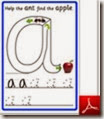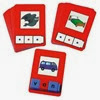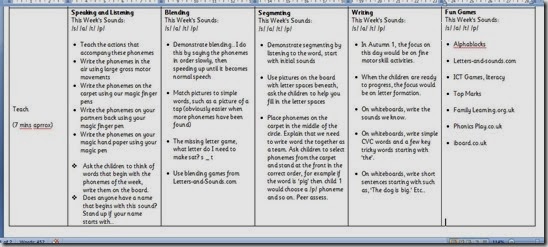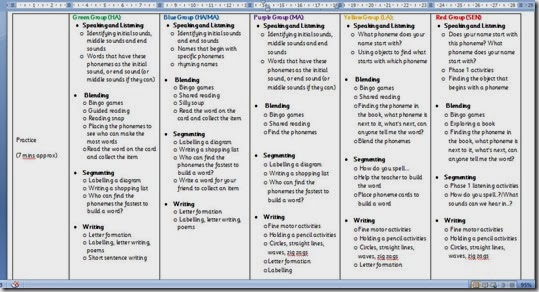30 Minutes Discrete Teaching
There are many different phonics teaching schemes each with their own merits.
- Jolly Phonics, ‘a fun and child centred approach to teaching literacy through synthetic phonics’.
- Read Write Inc. Phonics (also known as Ruth Miskin Literacy or RML) is a lively phonic programme that gets children reading and writing fast.
- Letters and Sounds, a phonics resource published by the Department for Education and Skills in 2007. It aims to build children's speaking and listening skills in their own right as well as to prepare children for learning to read by developing their phonic knowledge and skills.
- Sounds-Write is a quality first phonics programme and is acknowledged by the DfE as meeting all its criteria for an effective phonics teaching programme.
- Phonics International by Debbie Hepplewhite, Aimed at the parents/homeschoolers who want to teach their children to read at home using the 'synthetic phonics' approach.
And there are even more! For the correct pronunciation of the phonic sounds as they are taught these days, please see the Alphablocks!
Despite the different schemes, there is an advised lesson format for discrete phonics teaching.
- Revisit and Review
- Teach
- Practice
- Apply
Every teacher has their own way of doing things and this is my way. It’s not the only way but if you are looking for ideas on how to teach Phonics in Reception, this is an example.
Revisit and Review
You won’t be able to do this in week one (unless you want to review some Phase 1 phonics), but once you are on your second week of phonics teaching, you will be able to review the sounds you have already learnt and revisit teaching techniques such as blending and segmenting.
Your revisit and review should be a very quick segment of the lesson, possibly in a whole group situation or in a focus group, depending on how you set out your lessons. Personally, I review and revisit and teach as a whole class and then practice and apply in focus groups.
Games for Revisit and Review
- Flash cards!
I know, old fashioned and dated. What if you turn the flash cards as fast as you possibly can and see if the children can keep up. You can challenge them to see how fast they can do it! Challenge your target children to see if they know them all and reward with a large sticker. - Spot the Sounds/Words

I made a Smartboard game, a very simple one. I ask the children to make their hands into binoculars and we are going on a word safari. To begin with, the words are ‘and’ and ‘the’, however as the weeks go on, we review different words. - Initial Letter Sounds
Very quickly review on the board words that begin with your review graphemes. Write them on the board as the children shout them out. - Where is the Phoneme?
Challenge children to find the phoneme. Put some sparkly alphabet letters on the carpet with the children in a circle. Challenge the children to find the phoneme you say. For example, ‘Who can find sssss?’ (or you could say, ‘An ess?’).
Teach
Obviously this is where you teach new phonemes, blending and segmenting. In this section, you would teach something new. I split my week into speaking, reading, writing and fun games. It will depend how your time table is set out and how much time you have for phonics each day.
On Monday, I teach the new sounds. For example, in week 1 I would teach /s/, /a/, /t/ and /p/. I try to do this in a very physical way, using the actions from Jolly Phonics and getting the children up to draw the letters in the air, on the carpet, on their partner’s back and on their hand, all the time saying the sounds.
Blending is for reading, taking the graphemes that you have in front of you and blending them together to find out what the word is.
Segmenting is for writing, taking the word you have and working out what phonemes it consists of and thinking of which grapheme to use.
In a writing lesson, not all children are ready to start writing in Reception. It is our aim to make them ready by the time they leave Reception but as all children develop at different rates, we have to take their lead. In the first term, I would focus on fine motor skills linking to the letters of the week. For example, when doing /s/ /a/ /t/ /p/, these letters consist of waves, circles and straight lines which is what you could practice with lower attaining children or those with fine motor difficulty. I mainly use the teaching section of this lesson to demonstrate but if there is time, I encourage the children to have a try at writing.
Practise
I have split my class into 5 attainment groups and work with these attainment groups with ability appropriate activities related to the phonemes of the week.
Using assessment for learning in conjunction with the summative phonics assessment, I would select which activity the attainment group needs that week. Attainment groups would alter depending on what the target was for that week.
Apply
While I am practising with the focus group, the rest of the class is working with the teaching assistant, who is working as the Learning Through Play Manager, using independent phonics resources in the classroom.
In general, I try to make sure that there are the following activities available:
- Independent writing table
This table would have on it a number of different writing implements, such as pencils, pens, crayons, wax crayons, felt tips, biros, roller ball pens, chunky pencils, thin pencils and a number of different types of paper including wrapping paper, sand paper (not too rough), card, etc. This table would also include a variety of word banks and key words. Children would be encouraged to hand their work in – with their names written on it – at the end of the lesson to be collected towards writing evidence. - Letter formation laminated sheets

I made these letter mazes to encourage the children to form their letters correctly. Children seem to find it difficult to start letters from the top (with the exception of ‘e’ and ‘d’ who start in the middle) so I hoped that these maze examples would encourage children to form letters correctly. - Word building cards

Which you can buy on Amazon! Sometimes the children aren’t able to identify what the picture is, for example, sometimes if the word is ‘wing’ children say ‘bird’. I have my Learning Through Play Manager on hand to help! - Word building puzzles
- Capital and lower case matching pairs
- Phoneme bingo games (once all the children have been taught how to play).
- Letter carpet tiles for word building on the floor
- Naughty writing
Separate from my writing table, an opportunity for naughty writing to encourage boys’ writing. Children may be allowed to write outside on the floor in chalk, on paper taped to the wall, under a table or a long roll of paper on the floor. - Phonics activities on the laptops
- Alphablocks
- Letters-and-sounds.com
- ICT Games, literacy
- Top Marks
- Family Learning.org.uk
- Phonics Play.co.uk
- iboard.co.uk
- Talking tins with the sounds on, ordering the talking tins or talking postcards.
Evaluation
This section is similar to assessment for learning. I jot down notes about target children or anything that has stood out from that lesson to inform the next day or the next week.
But like I say, this is just a template. It may not work in your setting but hopefully I’ve shared some useful ideas.




No comments:
Post a Comment